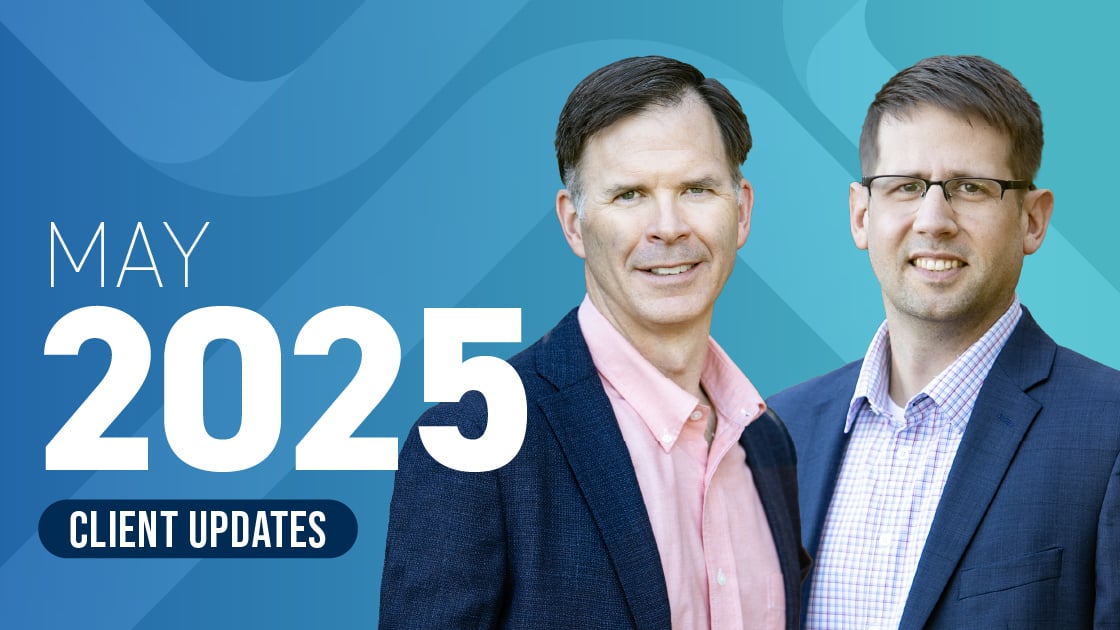How to choose a financial advisor (tips + questions to ask)
How to choose a financial advisor (tips + questions to ask) As a financial planning professional myself, there is nothing I love more than getting to...

Most people are frustrated, confused, and even afraid for their financial future. Have you ever felt that way? When you look at your financial life and all of the resources, opportunities, and investments in the United States, do you want to scream, “Why is this so hard?!”
We thought so. We've learned that most people struggle with these feelings. In fact, we’re right there with you in your fears and frustrations.
All any of us wants is a steady profit and to avoid the crashes. Sounds simple enough, right? But we’ve all had those moments when, out of fear, we run to cash at exactly the wrong time. Or when we hear our buddies bragging about their returns, we outwardly congratulate them as we inwardly stew.
You also have crazy ideas of aligning your investments with your values, the things you want to be right in the world. But you are not sure how to do this or how much profit you might give up. Does any of this sound like you? Yeah, we get it.

At Sound Financial, we’ve dedicated ourselves to values-driven financial planning and investment management for 30 years. We have felt the pain of failure and fear – of both loss and missing out. We have suffered the worry and anger of having a good education, a strong work ethic, and plenty of opportunities, yet we still struggle with the feeling of "not getting ahead." (We've had tremendous success, too!)
And during this time, we have continued to relate to how our clients feel and have developed investment processes designed to avoid significant losses while seeking steady, long-term profits.
Over the course of our 30-year history, we rode the go-go '90s, the dual crashes in the '00s, the slow growth teens, a global pandemic in '20, and the bond market crash in '22. During the financial crisis of 2008-2009, market volatility and business changes caused us to move our clients to cash by May 2008. I don't expect you to remember the exact dates and statistics, but the U.S. stock market lost more than 50% before bottoming in March of 2009 – a massive loss. Moving to cash was brilliant!
Our managing partner, Danny Matthews, was recognized as having "called the market." Danny was thanked so often that he started saying, "Thank God, not me. I'm not this smart." Business timing, not market timing, had a lot to do with that decision. Danny is smart. But internal business decisions, not brilliant investment skill, caused us to make those changes.
By the time the market recovered in 2010, we were still overly conservative. Danny was exhausted. And I (Chris) found myself in charge of our investment team. My previous training was on how to sell stuff, not manage money. But I liked math and orderly decisions, as did Joel Holden and Jim Towns.
When we looked at the markets, we saw numbers and graphs. And we knew, deep in our guts, that there had to be a better way. I wanted to scream, "Look at this! It must make more sense!"
The old traditional way of managing money (read a bunch of research and then make an educated, opinionated decision that sometimes felt like a guess) no longer worked for us. There had to be a better way! We wanted a determined, researched, and tested method of making investment decisions that produced long-term steady profits for our clients while avoiding market crashes. And so, we set out to discover that system.
Naming our strategy was never our top priority. In fact, it was years before I knew the industry name (“trend following") of the particular investing style for which we were searching. Still, few of our clients or readers care. This name is helpful, however; so, I give you a definition.
Trend following is designed to take advantage of uptrends, where the price tends to make new highs, or downtrends, where the price tends to make new lows. In regular language, buy what is going up and sell what is going down. Sounds simple enough, huh? But does it work? I will use a hypothetical test to illustrate the strength of trend following.
We tested the S&P 500 total return (TR), a traditional 60/40 model, and the S&P 500 TR with a trend following strategy from 1993-2022. The S&P 500's annual return over these 30 years averaged 11.2%. The 60/40 portfolio average 8.5% annually over the same 30 years. These are not bad returns. However, the maximum loss for the S&P 500 TR was over negative 50% and for the 60/40 portfolio was over negative 32%. I know very few investors who will hold onto an investment losing 50%. We thought we could do better.

We had to define what we believe is an uptrend or down trend. We used the 200-day average price as our trend signal. If the index price is above its 200-day average price, it is in an uptrend. If it is below the 200-day average price, it is a downtrend. We ran our test using these rules:
The average annual return of this hypothetical portfolio is 10.7%, and the maximum loss is negative 21%.
|
Index |
30-year average annual return |
Maximum draw-down (loss) |
|
S&P 500 TR |
11.2% |
51% |
|
Traditional 60/40 |
8.5% |
32% |
|
S&P 500 200D |
10.7% |
21% |
This test demonstrates that an investor can earn aggressive returns, keeping up with the stock market if that is your goal while avoiding crashes. We believe this test answers the question:
“How can I get steady, long-term growth and avoid stock market crashes?”
We also believe this test applies practically to financial planning, asking ourselves:
“Would we (as investors) give up only a one-half% per year, while still earning a great return, to avoid a stock market crash?”
Yes, we would!
With that agreement, we, together with our clients, can build true financial plans, seeking the needed profits to be successful — while avoiding market crashes that ruin financial dreams. So, we built our investment processes around ideas like the one I just illustrated. But we wanted to do so in a way that fit investors' behavior.
We learned that while these ideas test well and feel good in down markets, most people do not like the amount of trading that comes with a system like the one I described. Therefore, we incorporated these ideas over long time periods to minimize trading and (attempt to) maximize results. These are our stock sleeve definitions from our investment team.:
The Dividend Growth sleeve is designed to generate superior risk-adjusted returns to the Russell 1000 Value Index. The portfolio comprises companies’ stocks with consistent histories of paying and increasing dividends. We believe that a long-term track record of growing dividends indicates financial strength. The portfolio is constructed by starting with all members of the S&P 500 index, filtering for companies that have increased dividends for at least 25 years, rank the top 50 stocks based on price momentum, equal-weighted each position, and rotate annually.
The Growth Equity sleeve is designed to generate superior risk-adjusted returns to a 50/50 blend of the Russell 1000 Growth Index and the Russell 2000 Growth Index. The portfolio comprises companies’ stocks that have demonstrated solid top-and-bottom-line growth. The portfolio is constructed by starting with all members of the Russell 3000 Index, filter to include only companies with positive revenue and free cash flow over the previous 12 months, and rank the top 200 companies with superior revenue and free cash flow per share growth, price momentum is then used to select the top 50 companies’ stocks. These positions are equal-weighted and rotated quarterly.
The Equity MLI sleeve rotates between the Dividend Growth and Growth Equity stock sleeves based on leading economic indicators. We invest in dividend growth stocks when these indicators are negative and trade in growth equity stocks when the same indicators are positive.
The Dynamic Fixed Income sleeve is designed to generate superior risk-adjusted returns to the Bloomberg Aggregate Bond Index. The portfolio comprises domestic fixed-income ETFs that cover a variety of maturity and credit profiles. The portfolio is evaluated weekly and tactically rotates between ETFs that offer exposure to Treasury Bills, Treasury Bonds, and High Yield Bonds. The weekly exposure is determined based on relative price momentum.
Our Biblically Responsible Investments are built by screening these sleeves through the Biblically Responsible Investment Institute or Inspire Insight's screening tools. Our goal is to screen out companies that earn revenue in ways that harm people or the environment – please remember these screens nor we are perfect at this task.
Our investment models are built with these sleeves based on our client's financial goals and risk tolerance. For example, we may create the classic 60/40 model with 60% Dividend Growth stocks and 40% Dynamic Fixed Income, taking advantage of long-term, high-quality companies and trend-following risk management practices.
Or we may build a 70/30 moderate growth model with 70% invested in the Equity MLI sleeve and 30% invested in the Dynamic fixed Income sleeve using our trend-following ideas to push for growth and manage risk. We use these sleeves to maximize our best research while shaping an investment model to fit our client's goals.
We've learned that most investors have the resources and opportunities needed to succeed. Fifty% of Americans are in the world's top 10% wealth bracket. We live at the global epicenter of commerce and economic growth. All we need to do is be smart and participate.
Because we want you to be a successful investor (outrageously successful!) and believe that you have all the resources that you need to do so, our investment system is built with the "plenty" mentality, not a scarcity mentality.
If you have a scarcity mentality, always afraid of loss, fearing you will never have enough, then you won't take the needed risks to succeed. And when you do decide to take risk, you are anxious because you feel the deep need to make up for past losses. We want to eliminate that mentality, focus on our opportunities, and search out profitable investments while managing risk. At Sound, this is how we do that:
Throughout the United States, many investment banks and Wall Street gurus make market forecasts. These are, in essence, market predictions, answering un-answerable questions like, "Where's the market going this year?" Predicting the future is not necessary for investment success. Granted, it would be nice and would make profits easy, but knowing the future is the Almighty's space and we haven't been invited.
Most of the great investors we have read and learned from suggest that basing investment decisions on predictions is downright dangerous. In fact, that is something you should try hard to avoid. The reason is that you cannot do it with any dependability over the long-term. You might get lucky once, like we did in 2008. But it is not repeatable, nor is it worth the time and effort.
Howard Marks said, "I believe it's hard to predict the future. It's not that hard to predict the present. In other words, it's not that hard to understand what's going on today."
We developed our framework to understand what is going on today by answering four questions about the U.S. markets and economy:
The answers to these questions tell us the current position of the U.S. markets and economy, helping us to make broad investment decisions.
How can you use these strategies? We have worked with thousands of people over the past twenty-nine years, read countless pages of information, and know the statistics which tell us that most people want long-term steady profits and want to avoid market crashes. The more important question is, what do you want? What are your dreams and goals, resources, and opportunities?
We built these strategies to fit your financial plans. These are designed to fit into an overall strategy which begins by answering the question, "What do you want to accomplish?" The answer becomes the focal point, the goal from which we reverse engineer the financial steps needed to accomplish this result. Investment strategies should be supportive of your financial goals; they should never be your scoreboard.
So, if you wish to do this yourself, use everything in this article, read our eBook Money by the Book, read the top five books we recommend, and build a financial plan that you can follow to success. We wish you the best. Please contact us at Sound Financial if we can help you in any way.
And yet, if you want help, one-on-one financial goal setting, planning, and investment strategies to help you reach your goals, contact us. You will work with the team that developed these strategies and wrote the articles you find throughout our website (www.soundfsg.com). You will also find a listening ear and a determined process to guide you to your financial goals.
You can email me anytime, cmcalpin@soundfsg.com. I look forward to hearing from you!

How to choose a financial advisor (tips + questions to ask) As a financial planning professional myself, there is nothing I love more than getting to...

Real assets vs. financial assets (comparison + examples) When you start knocking on the door of needing to define real assets vs. financial assets,...

If you’re reading this, you likely have a goal in front of you that is challenging you to think about investment planning for your college endowment...

Financial Nihilism is a philosophy that suggests financial systems, markets, and even the concepts of money lack true value or legitimacy. Thank you,...

Building your business has been a journey of dedication, innovation, and resilience. Now, as you consider its future, you’re likely asking, “What’s...

What are investable assets? (definition + examples) If your financial literacy journey has led you here to our virtual doorstep to learn about what...